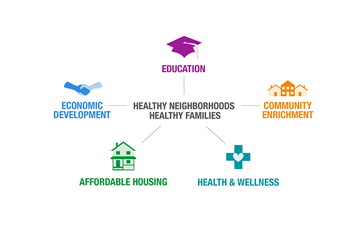Upstream Investments in Community Health: Nationwide Children’s “Roadmap” to Community Investment Illustrates What’s Possible
Nationwide Children’s Hospital may now be a model for health systems that want to invest upstream in its communities, but the road there was more than 25 years in the making.
Nationwide Children’s CEO Tim Robinson recently traced the hospital’s “more evolutionary than revolutionary” journey to its current community investment strategies in conversation with Robin Hacke, executive director of the Center for Community Investment (CCI). Their discussion kicked off a virtual summit, From Roadmap to Reality: Implementation Strategies for Upstream Investments in Community Health, hosted by CCI and Nationwide Children’s.
Nationwide Children’s first connected with CCI through Accelerating Investments for Healthy Communities, an initiative that demonstrates how hospitals, while staying committed to treating individuals, shift their focus upstream as a result of research based on social determinants of health.
“The work of investing in communities is really a work of many hands,” said Hacke, citing Nationwide Children’s Healthy Neighborhoods Healthy Families initiative as an example of “what can be accomplished when the health system joins with others in the community to make a difference upstream.”
Robinson said the journey to community investment actually began with the creation of Nationwide Children’s accountable care organization (ACO), Partners For Kids, in 1994. It is now one of the country’s largest pediatric ACOs, and it receives money to care for children covered by Ohio’s Medicaid Managed Care plans. When those children are healthy, money is saved and can be reinvested.
Partners For Kids helped refocus Nationwide Children’s toward prevention, disease management and care coordination.
“We were really incentivized to align wellness with our economic model,” Robinson said.
This alignment led to the creation of the Healthy Neighborhoods Healthy Families initiative, a place-based approach to addressing areas like housing, food security, workforce development and education. The initiative began in 2008 on the South Side of Columbus and has led to the investment by many partners of $50 million and the improvement or construction of 450 homes.
Nationwide Children found that its mission of upstream investments resonated with the existing values of both their board and their donors, and their ongoing support has been a result of the hospital’s ability to demonstrate the success of these initiatives. The hospital evaluates outcomes in many ways, including through a program called Pediatric Vital Signs, which analyzes kindergarten readiness, graduation rates, obesity rates, infant mortality and other metrics.
Much of Robinson’s and Hacke’s discussion centered on the issue of leveraging partners and financial contributions for successful outcomes. To raise funding for Healthy Neighborhoods Healthy Families expansion to a second Columbus community, for example, Nationwide Children’s had to get creative.
“Instead of raising capital in the form of equity investments, we did it in the form of a guarantee,” said Robinson. “By guaranteeing one and a half million dollars, we were able to unlock 10 times that much capital from banks and others who were a little more risk-averse.”
Nationwide Children’s has acted as an investor, a lender or a guarantor on certain transactions in order to leverage support from the federal and state government, such as the incoming federal recovery funds from the American Rescue Plan.
While Nationwide Children’s accountable care organization has inspired much of the hospital’s community investment, Robinson encouraged systems that have largely fee-for-service models to redefine their missions and begin leveraging resources and bringing others to the table.
“There's many, many ways for you to show up,” Robinson said. “It is important work, and it's work that's valued by the community.”
As for the community itself, Robinson emphasized the importance of ensuring upstream investments are conducted in collaboration with the neighborhood, empowering residents to drive the process – building trust is the “critical first step.”
Robinson also explained how Nationwide Children’s has managed the interaction between the clinical front-line staff and the people dealing with the root causes of population health issues through community investments. The hospital bridges this divide by working closely with community pediatricians who screen for social determinants of health, and it uses programs like Partners For Kids to connect families who are struggling with community resources.
By engaging on multiple fronts, health institutions can move upstream and create conditions that in turn, create health for an entire population.
“You're basically healing the neighborhood,” said Tim. “You're treating the neighborhood as a patient and raising all boats.”



